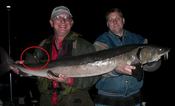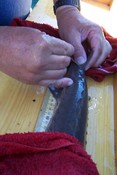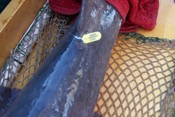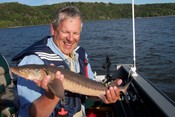 Since last October when Boone and his friend John hooked into this tagged Lake Sturgeon (that traveled 21.5 miles) I’ve been corresponding with MN DNR fisheries biologist Rod Ramsell, the lead of the St Croix River Lake Sturgeon tagging program.
Since last October when Boone and his friend John hooked into this tagged Lake Sturgeon (that traveled 21.5 miles) I’ve been corresponding with MN DNR fisheries biologist Rod Ramsell, the lead of the St Croix River Lake Sturgeon tagging program.
It was suggested that we might go out on a day when we knew there would be a few folks fishing for the Great Lake Sturgeon and collect fish from anglers to tag and help in the study of these strong yet fragile fish.
So with a little planning, I met up with Rod around 2 at a dock on the Croix. After removing a seat in the boat for more room, we brought on board his tagging equipment.
The equipment consisted of fish cradles, measuring board, scale, tape measure, a hollow needle, tags and a pile of towels.
 Once we let the IDA fisherman know we were ready, they flagged us down when a sturgeon was caught. We motored up to them and collected the sturgeon, then Rod kept the fish in the water while taking the girth measurements. Then the fish was brought into the boat and placed on the measuring board. Wet towels were used to hold the fish still and one towel was placed over it’s head to keep the skin and eyes from drying out and protect them from the sun.
Once we let the IDA fisherman know we were ready, they flagged us down when a sturgeon was caught. We motored up to them and collected the sturgeon, then Rod kept the fish in the water while taking the girth measurements. Then the fish was brought into the boat and placed on the measuring board. Wet towels were used to hold the fish still and one towel was placed over it’s head to keep the skin and eyes from drying out and protect them from the sun.
 Once the girth, length and tag was inserted and recorded the weight was taken.
Once the girth, length and tag was inserted and recorded the weight was taken.
We used the cradle for weighing the larger fish. Rod stressed the importance of not holding a large fish vertical whether it be a sturgeon, muskie or catfish…any big fish.
Then the fish were check to ensure they were ready to swim away and released.
 We ended the day with twenty five fish being tagged. I’m sure Rod will supply some numbers for us once he’s back to work.
We ended the day with twenty five fish being tagged. I’m sure Rod will supply some numbers for us once he’s back to work.
We talked about the possibility of this type of tagging again in October and if that happened, we would need more DNR staff to help. We had our hands full and I know some fish were released because we couldn’t get to them fast enough.
Rod wanted to thank all the IDA guys that helped in the tagging today. The more fish that are tagged the more and better info the DNR will have to make decisions on how to best manage this unique fishery that’s in our back yard.
I want to give a BIG THANKS to Rod for giving up an afternoon of his own time to show us first hand of what goes into tagging.
I truly believe that if the MN DNR followed Rods lead in working with the public more, not only would we be a more informed public…but it might help the DNR in a number of ways too…
As the saying goes…
We are all in this together.
How do you tell the sex of a Lake Sturgeon???
The first pic on the left is a female…it has a round orofic.
The next is of a male. They are generally “y” shaped.
It’s harder to tell on smaller fish, but as they get older it’s fairly easy to spot.
It was an interesting day out there, I am glad I could do my part in helping out
I think the team of DNR guys is a very good idea if the fish are biting like they were yesterday. I suspect 3 times as many could have been tagged with a team at hand.
It was hard to be picking up more fish when we were tagging the ones we already had.
Here’s a link to report tagged sturgeon numbers to.
Reporting Tagged Sturgeon<<<
Your info on these recaptured fish is very important to the St Croix River Lake Sturgeon Project.
Please remember to leave the tag on the fish.
Here’s a couple more photos of the tagging process.
The photo with the double catch was Mr. Hanson and Rushing.
The Crestliner was Mr. Aqua Joe.
The last photo was of Rod Ramsell taping a sturgons girth while it was still in the water.
Did you guys see the sack depth on his net!
Someone should try to get the DNR out on the 22nd of this month, they could be busy.
Way cool post Brian! I couldn’t see much difference in the male/female orifice (sp)?
I’m going to have to take a look next time to see if I can sex my fish. Did I say that right?
Hayward, those were a couple pretty small fish. It’s much easier to see on a larger one.
Look at the opening itself…ones oval and the other ones more of a slit…female =round holes for round eggs.
Here’s the data that was collected that Saturday.
*************
Here’s the run-down on the fish that were tagged last Saturday:
23″=3 fish,
25″=5,
26″=3,
27″=4,
28″=1,
31″=1′
33″=1,
34″=1,
40″=1,
41″=1,
46″=1,
50″=1,
51″=1 for a total of 24 fish tagged.
There was also the recapture of a 33″ tagged fish, making a total of 25 fish handled and data collected for.
The tagged LKS that was recaptured by Tyler’s boat on Saturday (September 15, 2007) was tag number 87147 and measured 855 mm in length (33.66″), 290 mm in girth (11.42″) and weighed 6.75 pounds. We originally tagged that fish on May 11, 2007 about 3.3 miles down stream from where it was recaptured. The length of that fish at that time was 817 mm (32.17″), girth was 280 mm (11.02″), and the weight was 6.40 pounds. A lamprey was removed from the fish at the time of tagging. This individual fish is showing above average growth for LKS in the Lower St. Croix River system.
(Edit: I received a number of questions about why the DNR are tagging these fish)
In answer to the questions about what we are using the tagging data for, here are the assessment parameters that we are looking at presently:
1) Develop a estimate of the total LKS population,
2) determine the size structure of the population (percentage of fish of various sizes in the population),
3) evaluate the relative condition of individual fish and the average for the population (length vs. weight relationship),
4) evaluate the average growth rate of LKS in the St. Croix River,
5) determine the catchability and vulnerability of LKS to targeted angling pressure,
6) movement trends in the river, and
7) their preferred habitat in the river system.
Items 6 and 7 are limited in their scope at this time and is dependent upon data collected from initial capture and reported recaptures. These parameters will have more substance in the future when we are able to start attaching transmitters and tracking the movements and habitat use of individual fish of various sizes on a daily basis.
How will that data be used? Ideally it will be used to insure that this species continues to exist and thrive in the St. Croix system into the future (long after current generations of anglers are gone!). It should serve as a foundation for biologically based management decisions to enable this goal. Whether it leads to changes in harvest limits, sizes, or seasons, or even protection of the population through no harvest remains to be seen. Without this information, decisions on how to manage these fish would be less informed and more susceptible to mistakes.
…Rod
Good Stuff!
Thanks Rod and Brian!
This has been an awesome read

Way cool!
Bump to the top for the 2009 Season coming up on Sept. 5th
Any chance that this could happen again this year? Seems like a great way to get some fish tagged.
I’ll be checking in with Rod and let you know.